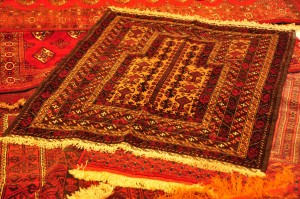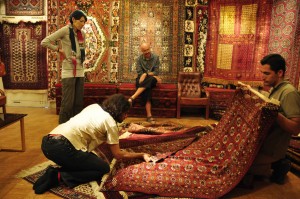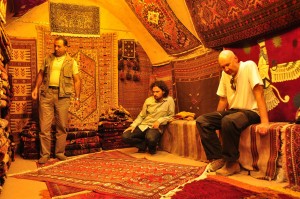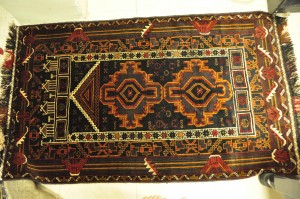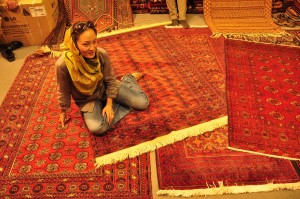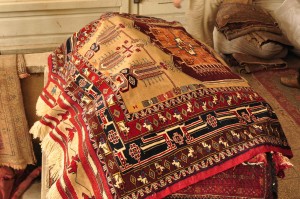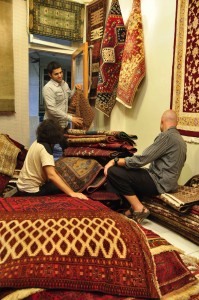When we first started our trip, I had a little mental list (and budget set aside) for a few things I intended to pick up along the way. It was only a small list, I am not really given to souvenir shopping and this trip was quite importantly a chance to de-couple a bit from the material world. But I did like the idea of investing in a few quality pieces, unique embodiments of cultural experiences if you will, where the shopping would be as much part of the travel experience. To date I have only crossed a single item off this list, a small Tibetan Mandala (Thanka) from Nepal, I had also planned to buy a drum in Africa, but nothing really grabbed me there unfortunately and of course I felt compelled to pick up a carpet in Iran. Given Persian carpets are universally considered to be the best in the world, I did not want to pass up the opportunity when making all that effort to actually travel though Iran, it just seemed the logical thing to do.
Now, I know nothing about carpets really and had done no real research. Up against sellers with thousands of years of history, expertise and skill behind them, this was not a particularly thrilling prospect. Fortunately though, I had a partner in crime. Victor, a great mate from Tokyo had dropped by to join us for the Iranian leg of our adventure and was able to bring a sprinkling of knowledge, some basic background and most importantly some fresh enthusiasm to the quest. Keen as we were though, we still had no reference points in terms of prices, style preferences or quality, so when we spied an expensive looking Iranian carpet trader in a mall in Dubai, we ducked in for a bit of a sighter and practice run.
Carpet shops all tend to operate on a fairly basic formula. You walk into a shop with something interesting in the window or on the walls and starting looking around rather intelligently. The seller will then get excited, offer you a seat and most likely some tea and then start digging into his many piles of carpets. As he opens specific pieces up, he will hold them out and displaying them on the floor, stacked one on top of another into a large pile. Initially he goes through a wide sample of his inventory and as you make a show of appraising each piece, he tries to get a feel for what you are after so he can narrow down the style of carpets you might be in most interested in. When you have both worn out the options, he then goes back through the large pile on the floor one by one discarding any you don’t like. The final pieces are then isolated for your consideration and initial prices are given and more detail provided on the respective carpets background, key features. If something does take your fancy, then the negotiation process begins.
What you are interested in is the tricky bit. Carpets tend to come in 3 sizes big, medium and prayer mats (small) and there are thousands of different designs. A few decades ago there were as many as 7 million people making carpets in Iran and carpet shops are just about everywhere, dominating large sections of every bazaar. These days we heard that the number of people has declined to under 1.5 million, but its’ still a lot of people and given that some of the better carpets can take many months to a year to create, its a huge income provider.
Carpets are produced throughout Iran as well as the neighbouring regions of Azabaijan, Afghanistan, Turkey and Turkmenstan. Each area tends to specialize in a different style and carpet shops tend to accumulate their own network of providers or producers within a certain style range (or for those that do target foreigners accumulate a range of carpets that suite the Western taste). Esfahan is probably the most famous region, specializing in pure silk carpet designs of the highest quality with spectacular, complex floral arrangements similar to the designs of the Iranian mosques. But there are many other variants regionally which work to their own traditional patterns. And then there are the nomadic tribes, which produce carpets in their own distinct style based on the things they see around them. Often they can produce totally unique pieces inspired by every day life, with little pre-planning, they are usually slightly flawed but entirely original.
Judging a carpet is a complicated process – carpets tend to be classified (and priced) based firstly on whether they are made from Pure Silk, Pure Wool, Silk / Wool, Wool & Cotton or numerous other subtle variants (ie. camel wool or lambs wool), the gist being that the more silk used, the higher the price. Then there is the quality of the knots; carpets can be single or double knotted and are generally measured on the number of knots to an inch. The more knots the higher the quality which can be easily seen by turning a carpet over, the higher the quality of a carpet the more clear the design on the back of the carpet will appear to be. Age plays a part as well, older carpets tend to be a lot softer and are valued more highly. Starting to get the idea?
As we sat in our Iranian shop in Dubai feigning genuine purchase intent, I started to comprehend this rich and complex world as the carpets mounted on the floor in front of us. The incredible detail and quality of the Esfahan carpets was captivating, but the pre-dominate bright turquoise and white colour schemes just seemed to clash with everything I could conceive and I really wasn’t looking to spend thousands. The nomadic carpets however were much more interesting, deep / rich tones of red, the elegant designs of Turkmen & Belucci seemed to resonate well, more especially with Victor and the price tags around a thousand dollars or so seemed somewhat in reach. We had some benchmarks, some style ideas (and some budgets), promising we would think about we managed to escape the store. We were ready for Iran.
After checking out a carpet shop very briefly in Shiraz, we made our way to Yazd in the dry desert centre of Iran. As we were exploring the ancient mud alleys of the city, we stumbled across a small carpet shop with several large backrooms stacked full of what looked to be very interesting designs. Some quick investigations with the manager revealed that the shop specialized in Zorastrian carpets made largely by and for the Zorastrian community and that the carpets had largely all been pre-owned. A pretty interesting angle really, especially as we both had some fascination with the Zorastrian religion and rituals, so Victor and I settled into see what he had. Zorastrian carpets are quite unique in that they feature designs of fire temples, lotuses and many other practical features of daily life that make for especially good ‘carpet sales’ storytelling, it didn’t take either of us long to find something we liked and after going through the motions, had reduced our piles to a few specific final selections and were ready to negotiate. In the end I walked away with a small, 20 year old Zorastrian designed carpet for around $265, he had started at around $300 or so I think, but really had refused to negotiate – it was all price fixed by the community or so he said. I still thought it great value relative to what we had seen in Dubai though and our later forays revealed this to be the casse. Victor nabbed a very nice, medium sized Turkmen as well for about $450.
Our first big carpet trial and we had bitten the bullet already, which really took the pressure off. We were both happy and with our carpets wrapped up in newspaper and compressed into a small package, we continued onto Esfahan, famed for its bazaar and carpets alike. While Victor already had a big piece, I was still a little looking for one, so the focus was one me to find something I liked. We tried perhaps 4 or 5 tourist friendly stores specializing in nomadic carpets and after sitting down to various welcomes and tea, had hundreds of carpets thrown at us. Steering clear of the expensive Esfahani carpets, the initial ‘wow’ of it all was starting to wear off and while we came close a couple of times nothing was really grabbing me. Megumi meanwhile had started to go carpet blind and could no longer differentiate between them. So we decided to wait and see what the bazaars in Tehran held.
The Tehran bazaar turned out to be a massive labyrinth, largely domestic focused and very difficult to navigate. Carpet touts hang out at the entrances though waiting for tourists like us to rock up and guide them to key market sights and ultimately see their shops. We were found by a couple of such guys in our forays and led through the rabbit warren into huge carpet warehouses, replete with little backrooms on the upper stories for intimate display. All were incredibly friendly, spoke english and tended to specialize again in the nomadic pieces we were more inclined towards. A couple of times we found ones we liked, the price & range definitely better here than Esfahan, but we had a few days to explore, so we kept the pieces on hold and gave ourselves the chance to keep looking. Eventually as it always happens, we were wandering down a small alley, with carpet stores and squares spiralling off to all sides when a young guy speaking good English asked us if we wanted to see his shop. I am in Lonely Planet he said and shouted his name which I actually recognized from the bible. It was a good omen, so we followed him to his little room, braving the lack of air conditioning to check out his range. Jackpot! Hosseiny as it turns out travels a lot across both Iran and neighbouring lands buying interesting carpets from all around, but rather than focus on one style, he had an amazingly diverse range of quality pieces on offer, exactly what we had been looking for.
After pouring through the wide array of options, we found several pieces we both liked and went through the difficult task of paring it down to a final selection. After some constructive prompting from the support team, I dived in with a magnificent and totally unique masterpiece from a nomadic master near Sharvin in North Eastern Iran, while Victor picked up an excellent quality prayer mat. As luck would have it Hosseiny was also looking to just clear out his inventory so was willing to cut us very good deals just to move his merchandise. (at least that was his rather genuine story) My carpet cost about $600 in the end, he claimed he would normally expect to get at least double that which made me feel good.
Task and mission over, satisfied buyers both – Victor generously smuggled the pieces back to Japan for me, so I will have to wait another year or so to see them again. It will be a much anticipated reunion. Leaving Iran though, I was also filled of dreams of all the other pieces I would have loved to have bought and likely would have done had I even the remotest possibility of more floor space somewhere down the track. The colours, designs and weaves are all entrancing, but it is the intricate background stories and unique lifestyles wrought in thread that each piece immortalizes, that really draw you in. And in all, I found the experience thoroughly rewarding. The Iranian sales process was not the bullying, intimidation that I had imagined at all, but a largely pleasant, considered interaction and so it always should be I think – culture is being traded here.
![On Buying Persian Carpets When we first started our trip, I had a little mental list (and budget set aside) for a few things I intended to pick up […]](http://meltingplots.com/wp-content/uploads/2010/07/Top2.jpg)
